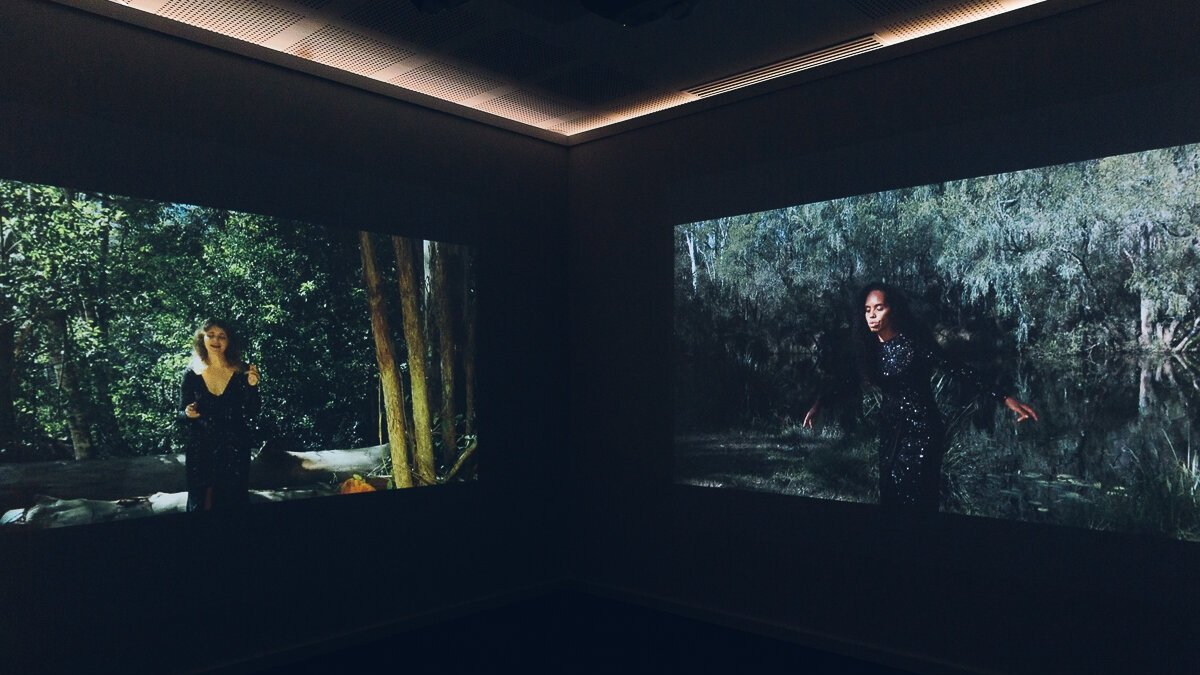







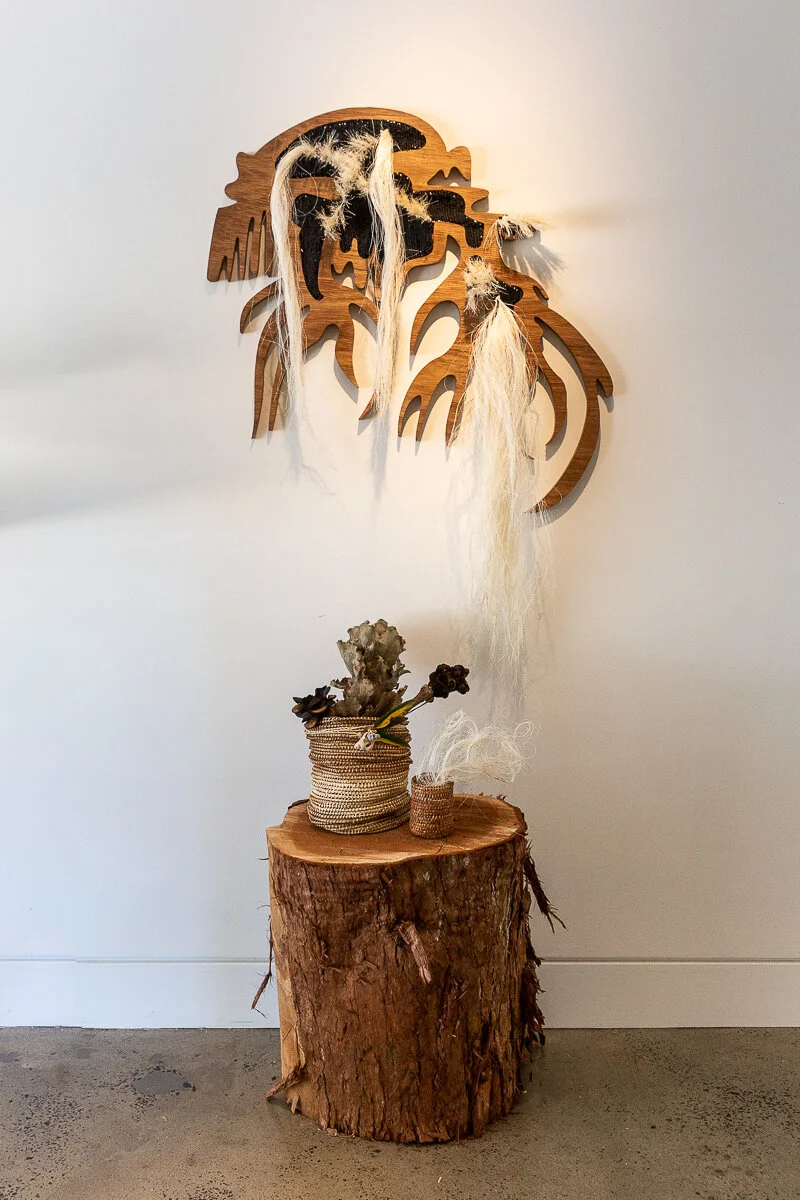




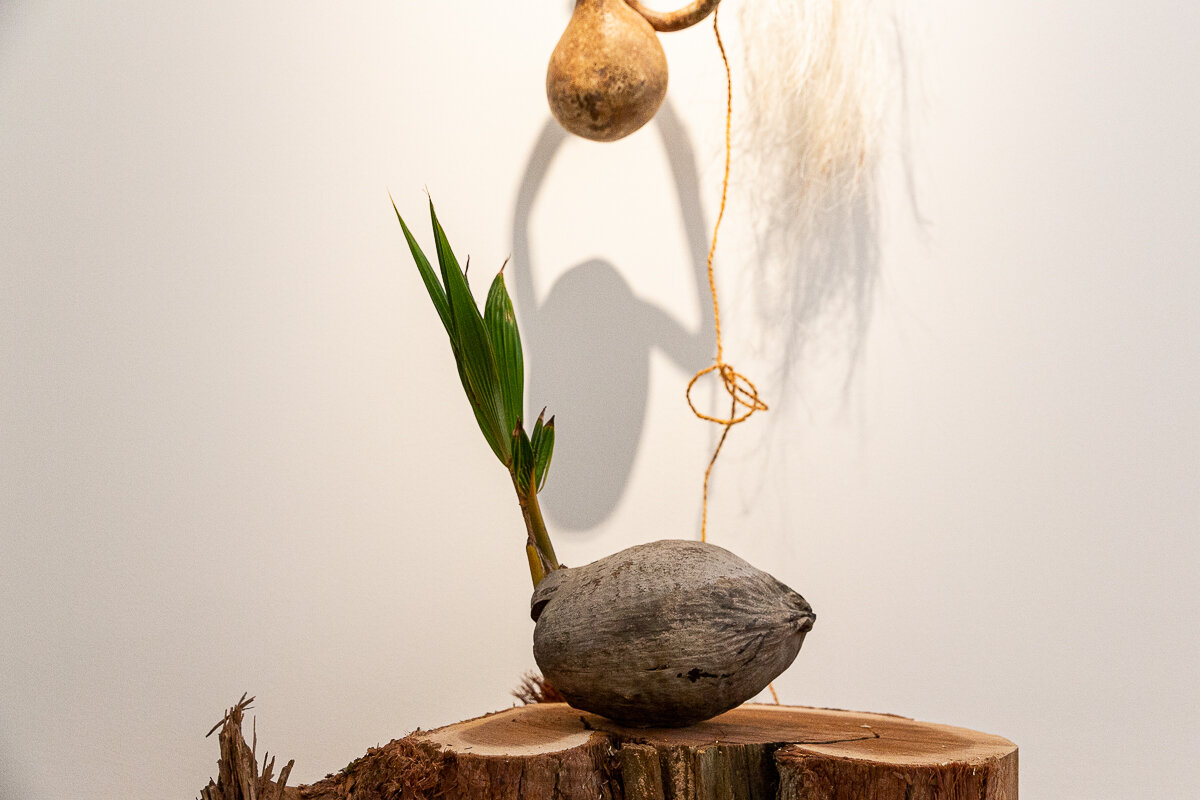




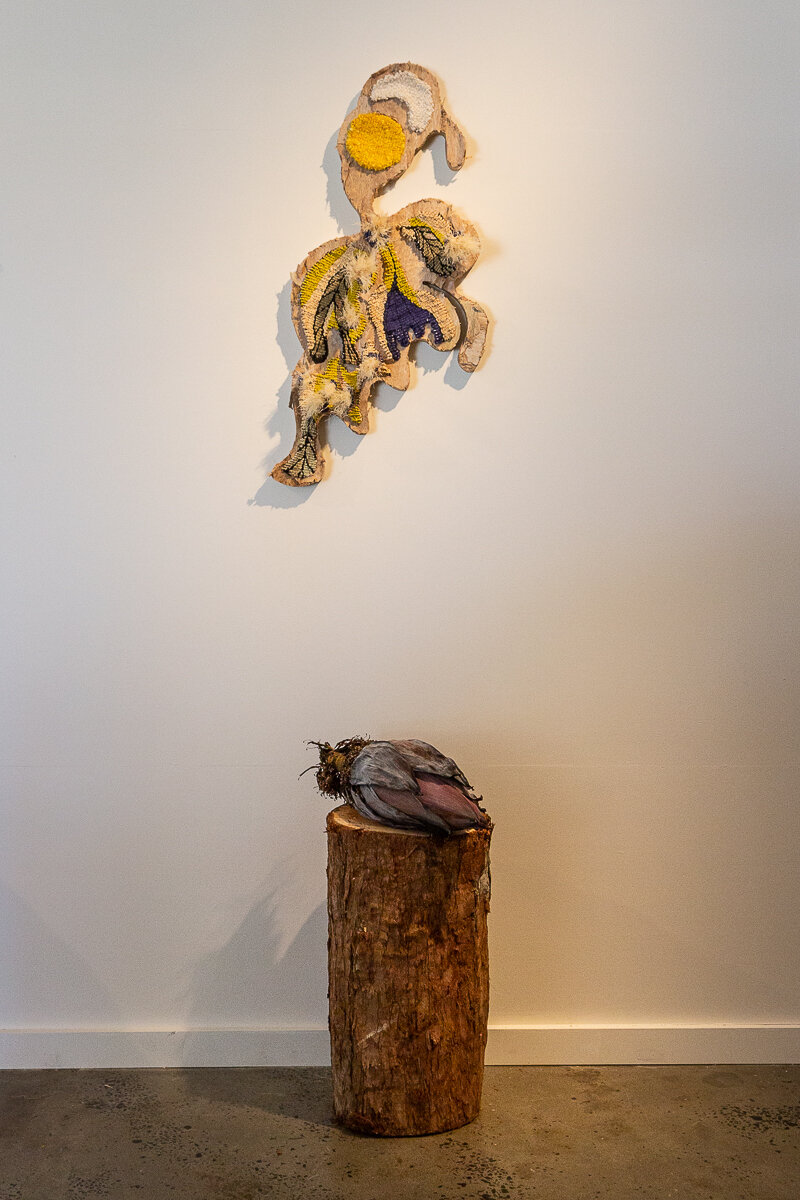




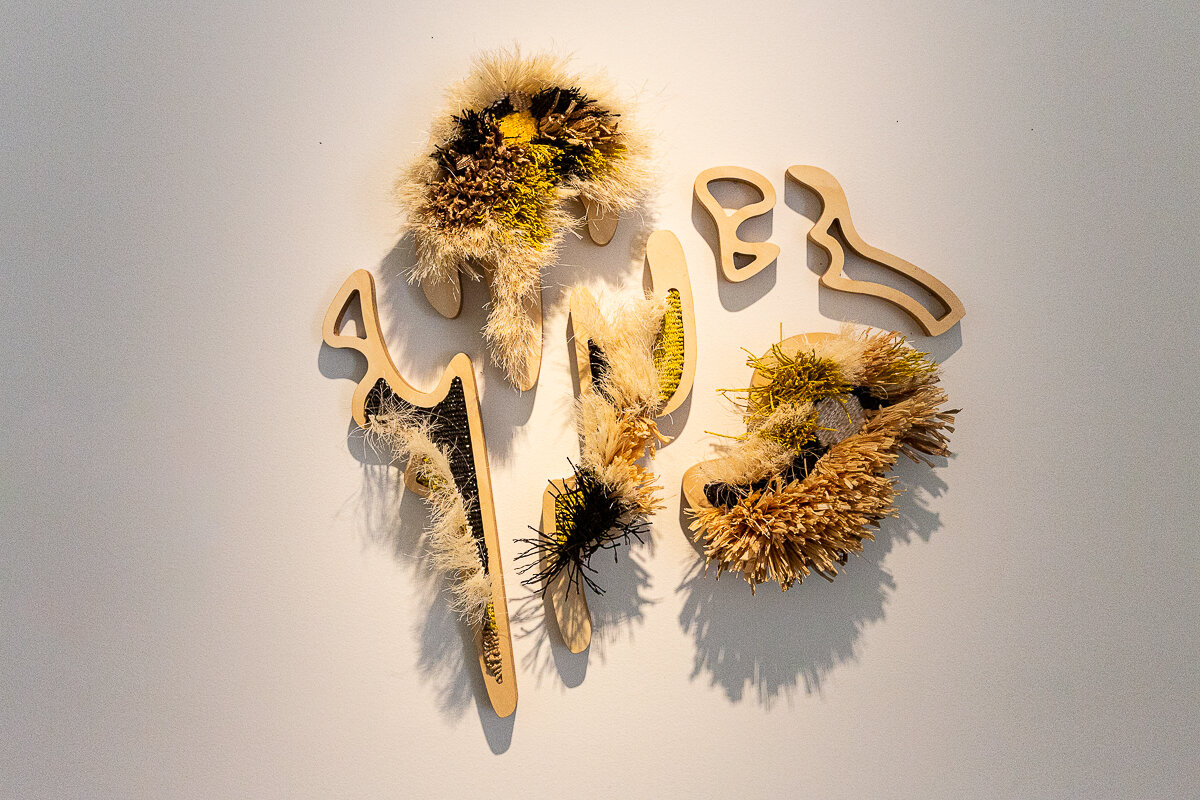

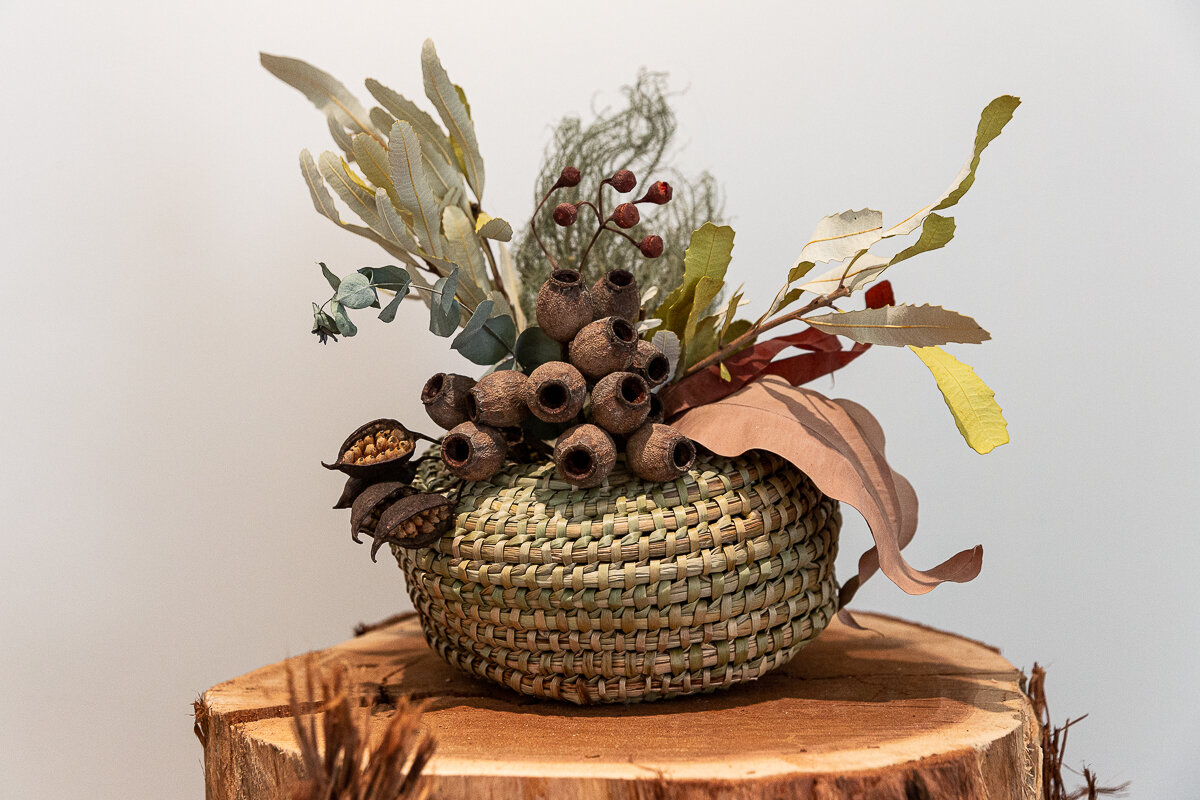

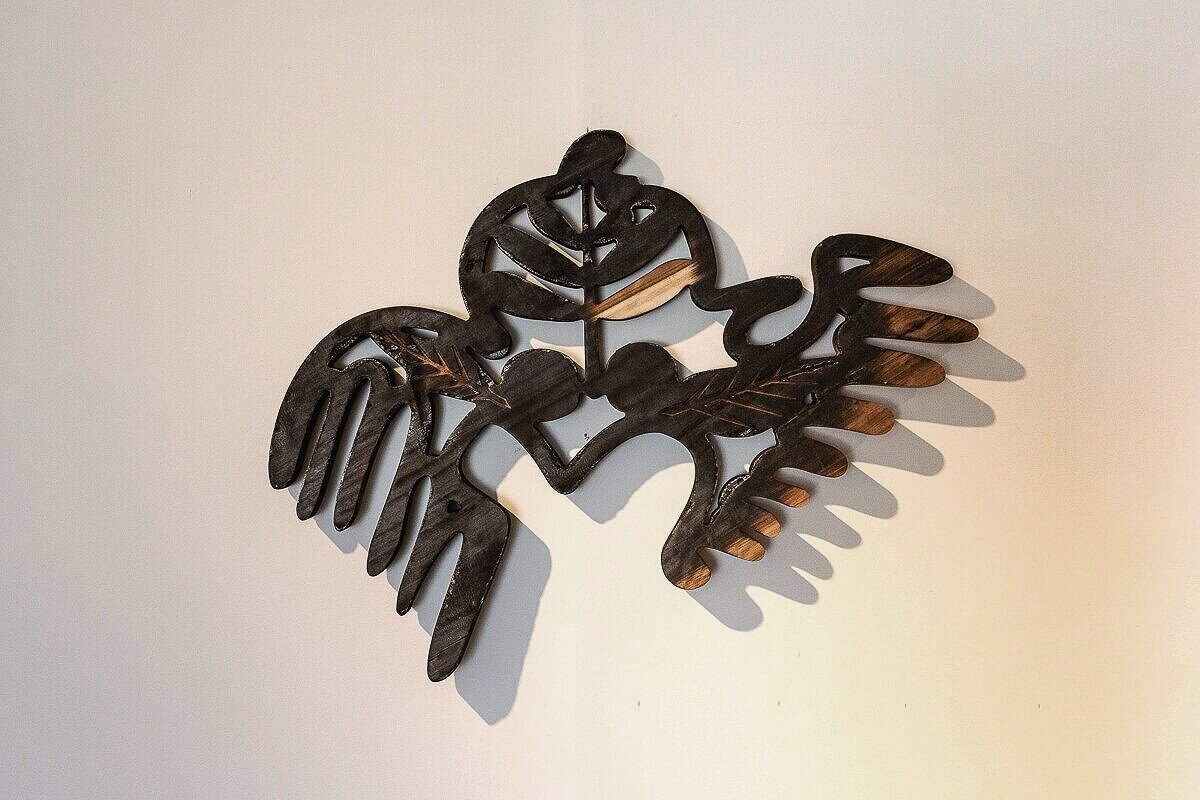









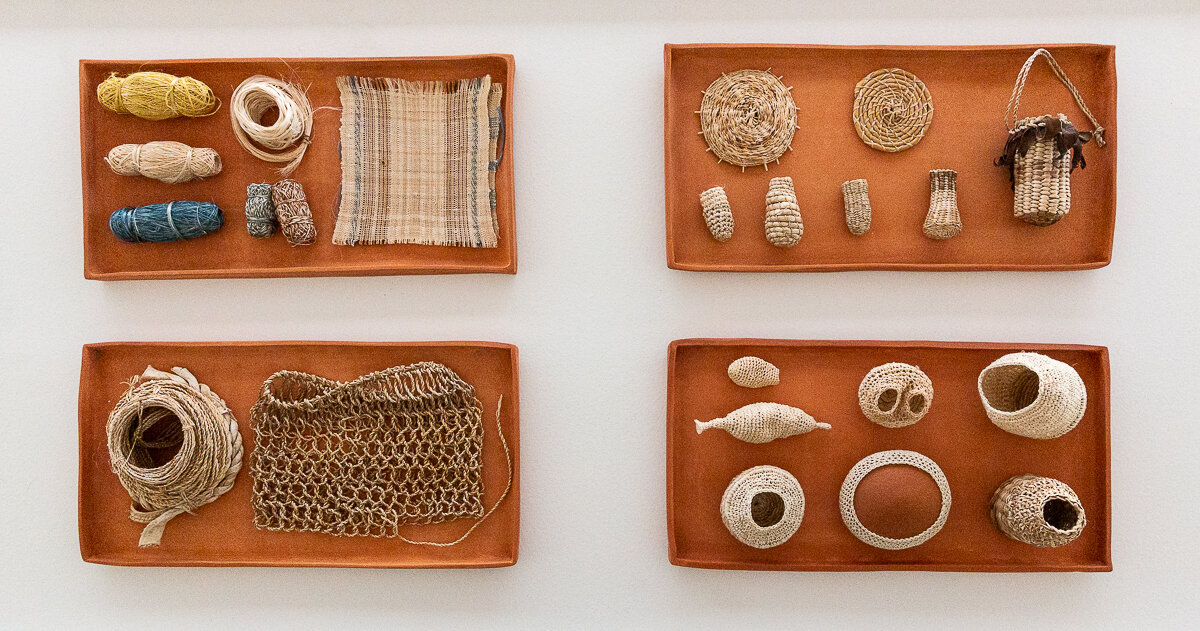
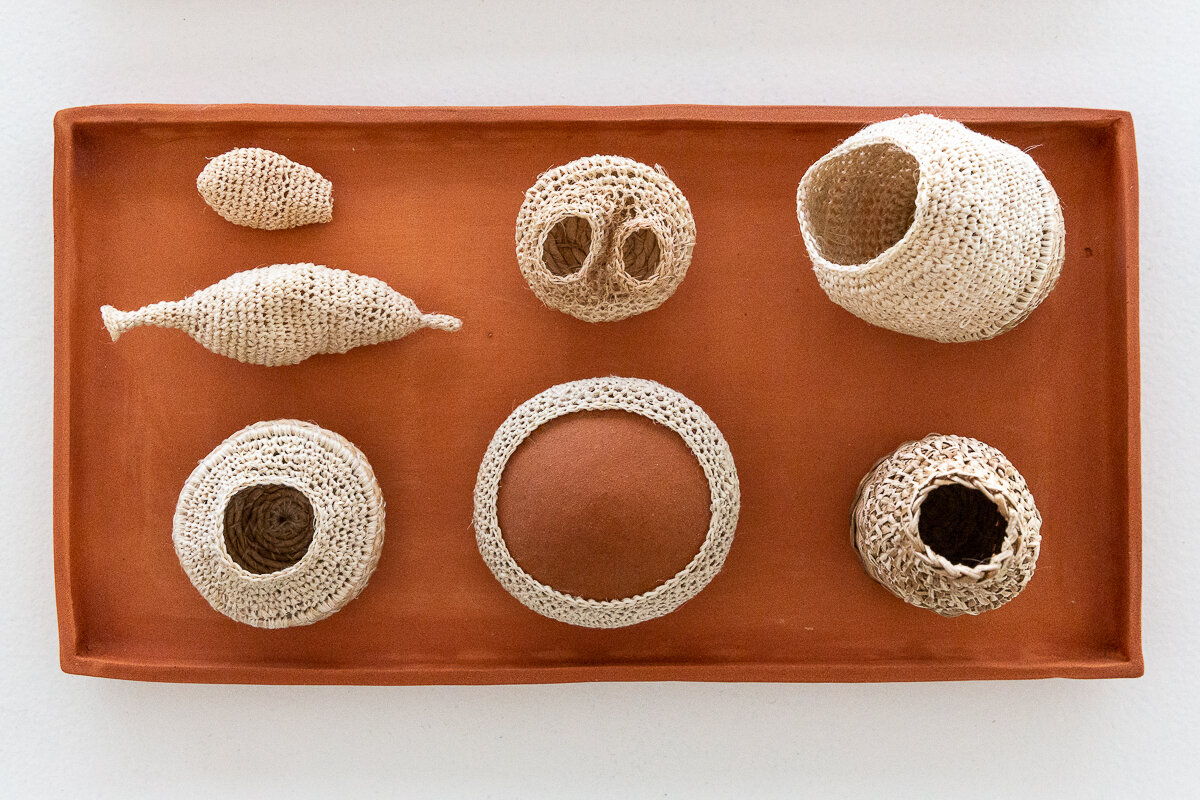

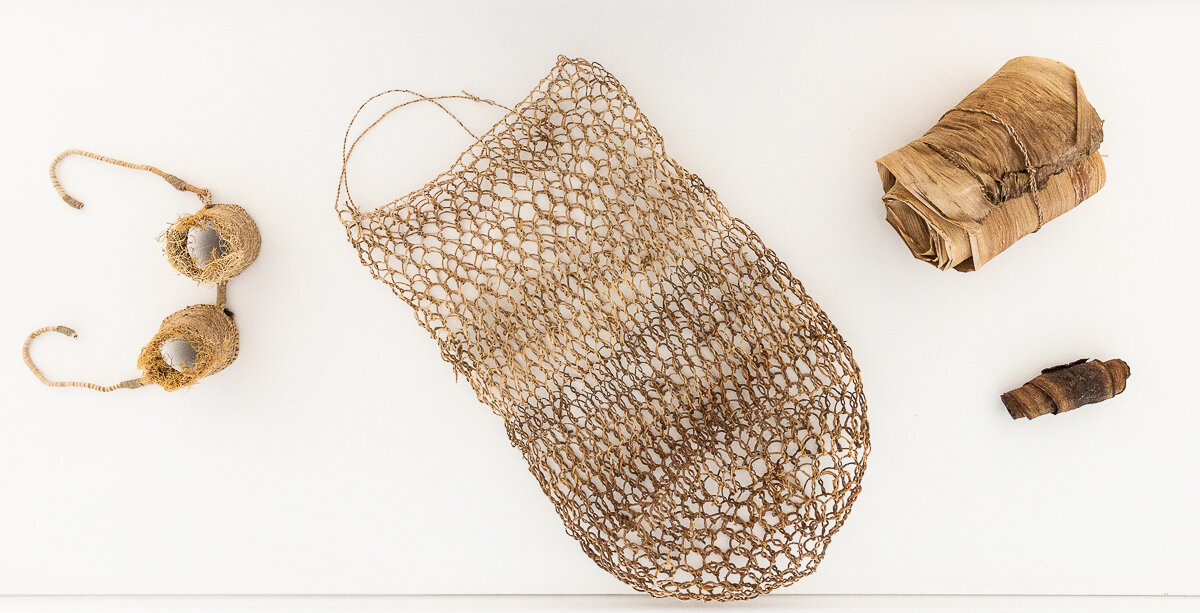
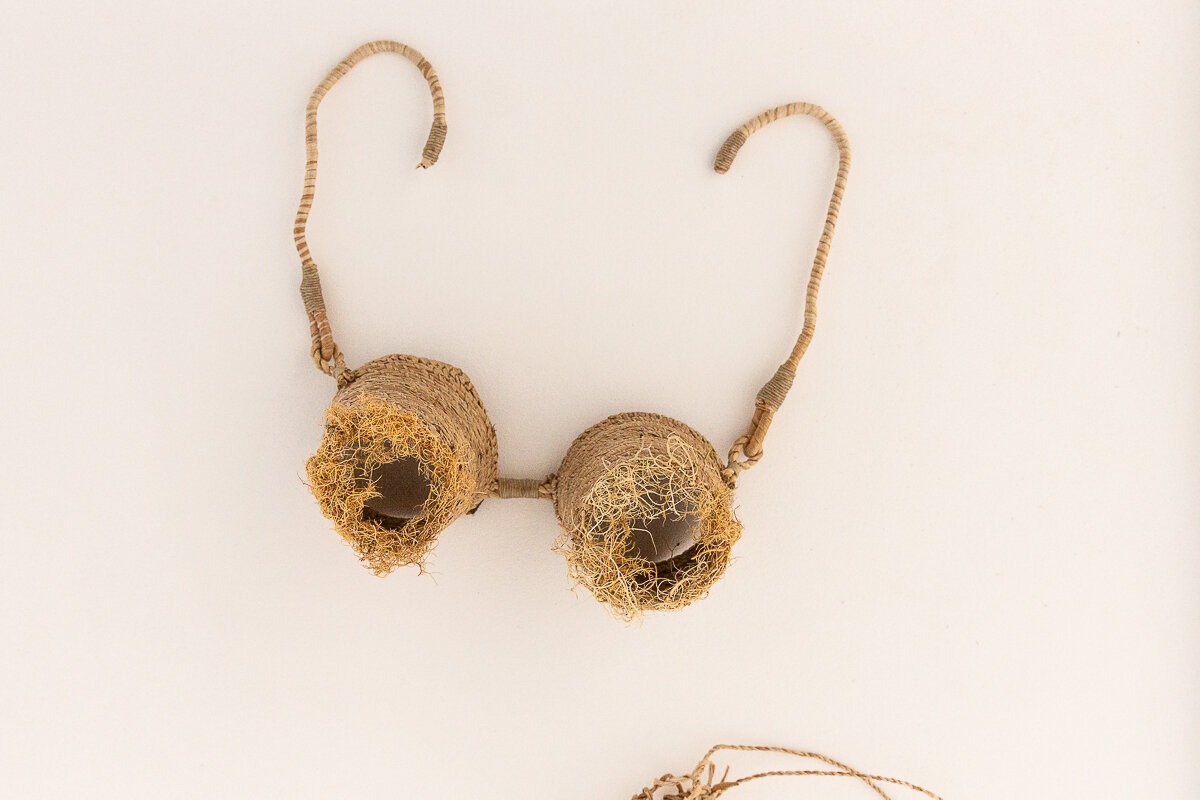





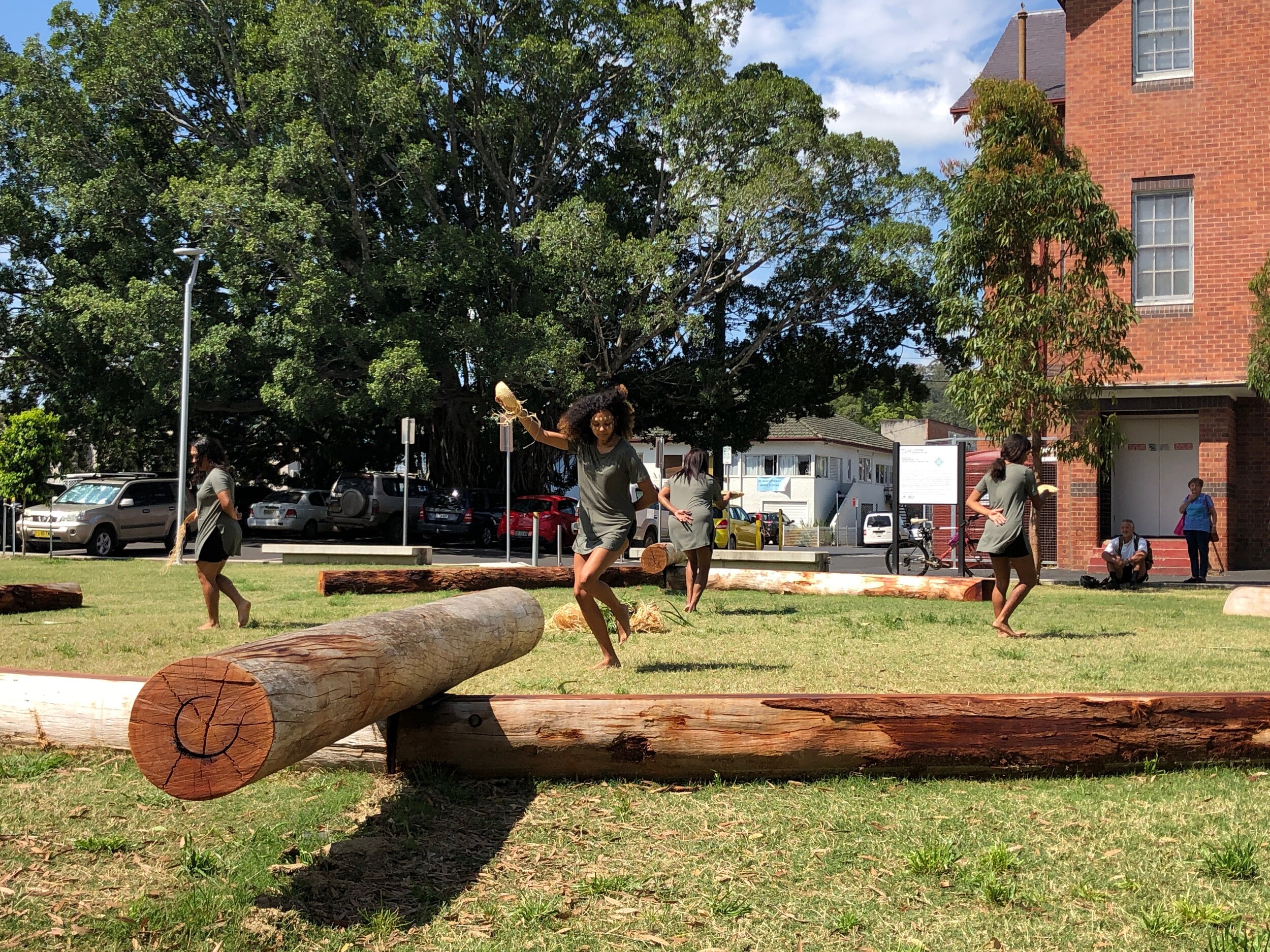
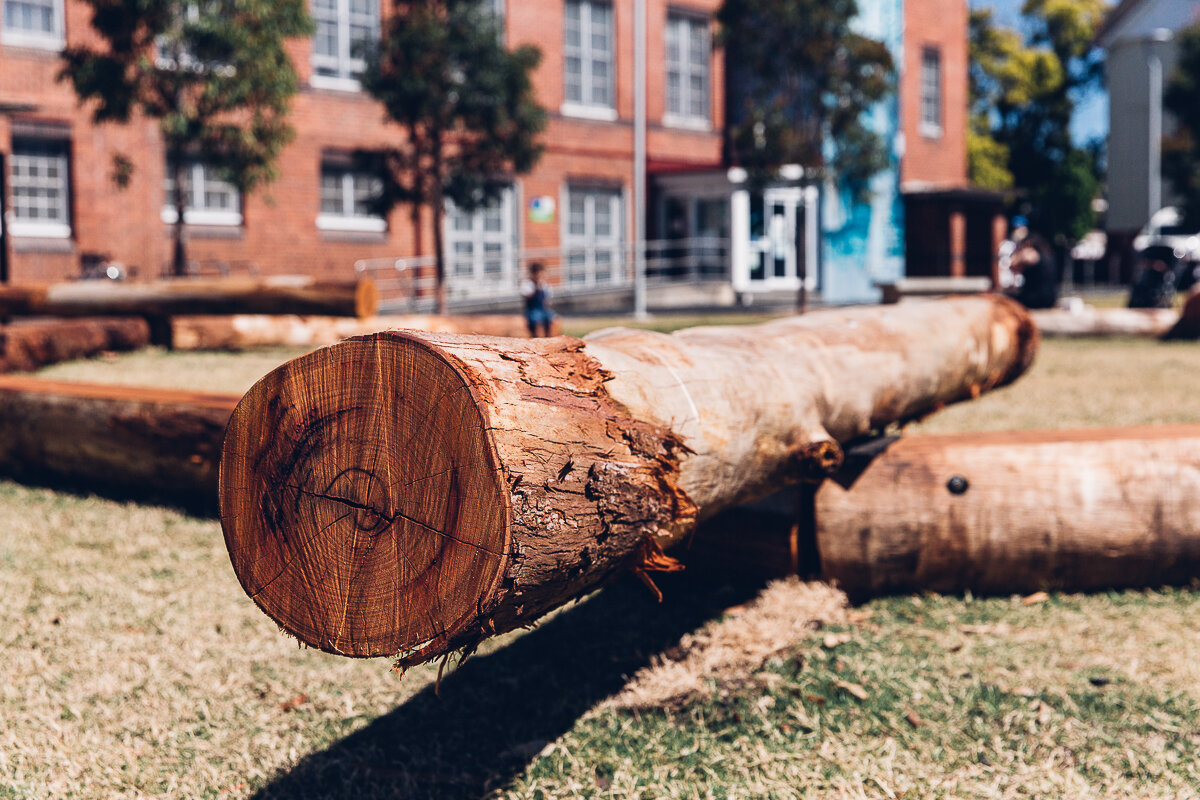
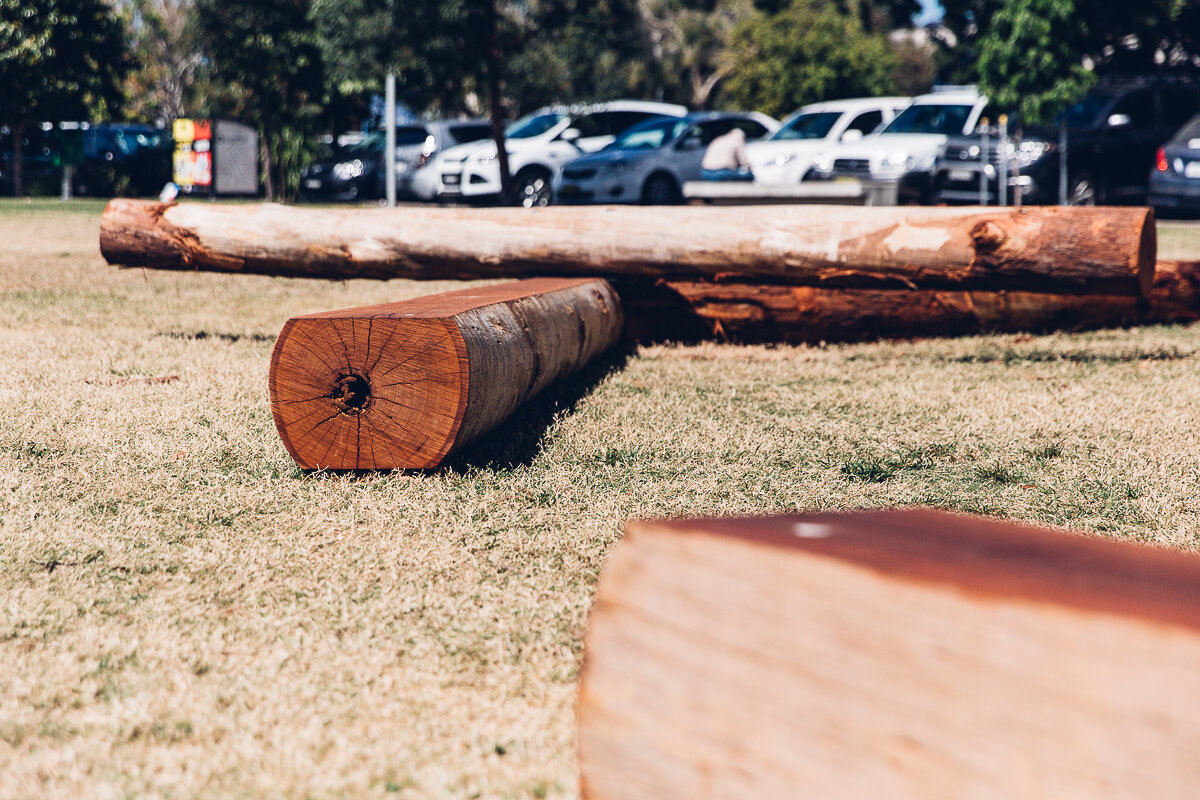



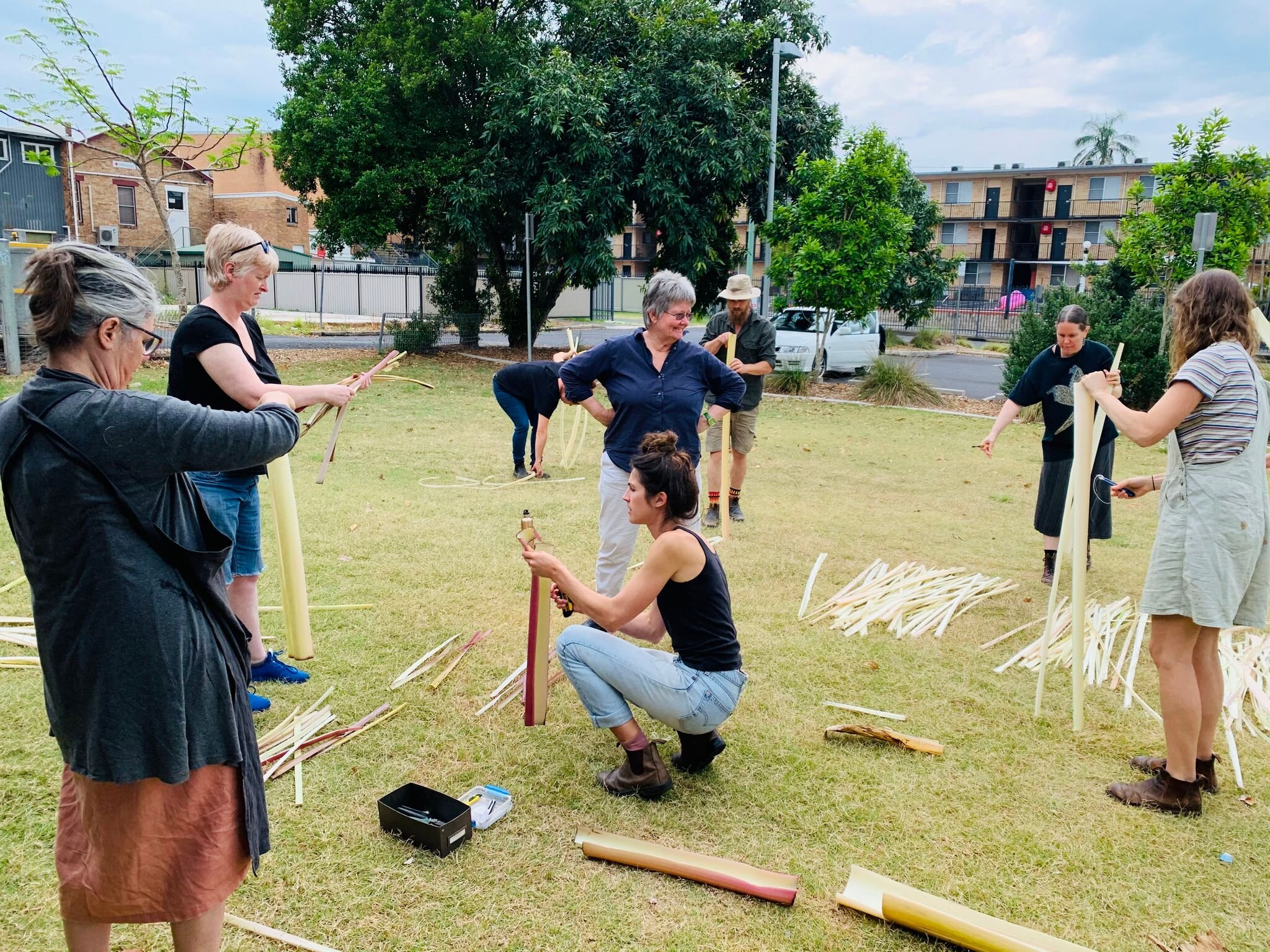
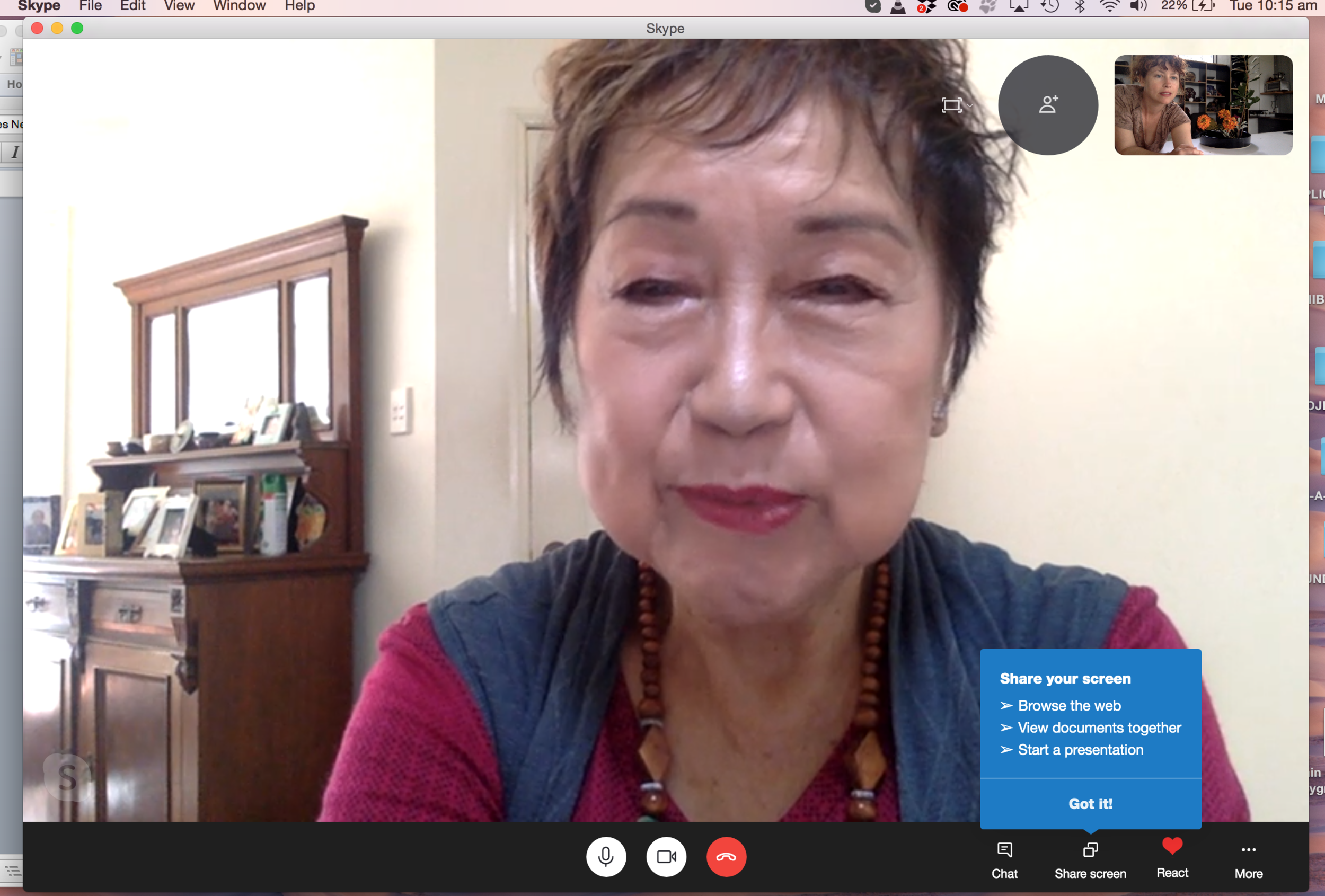

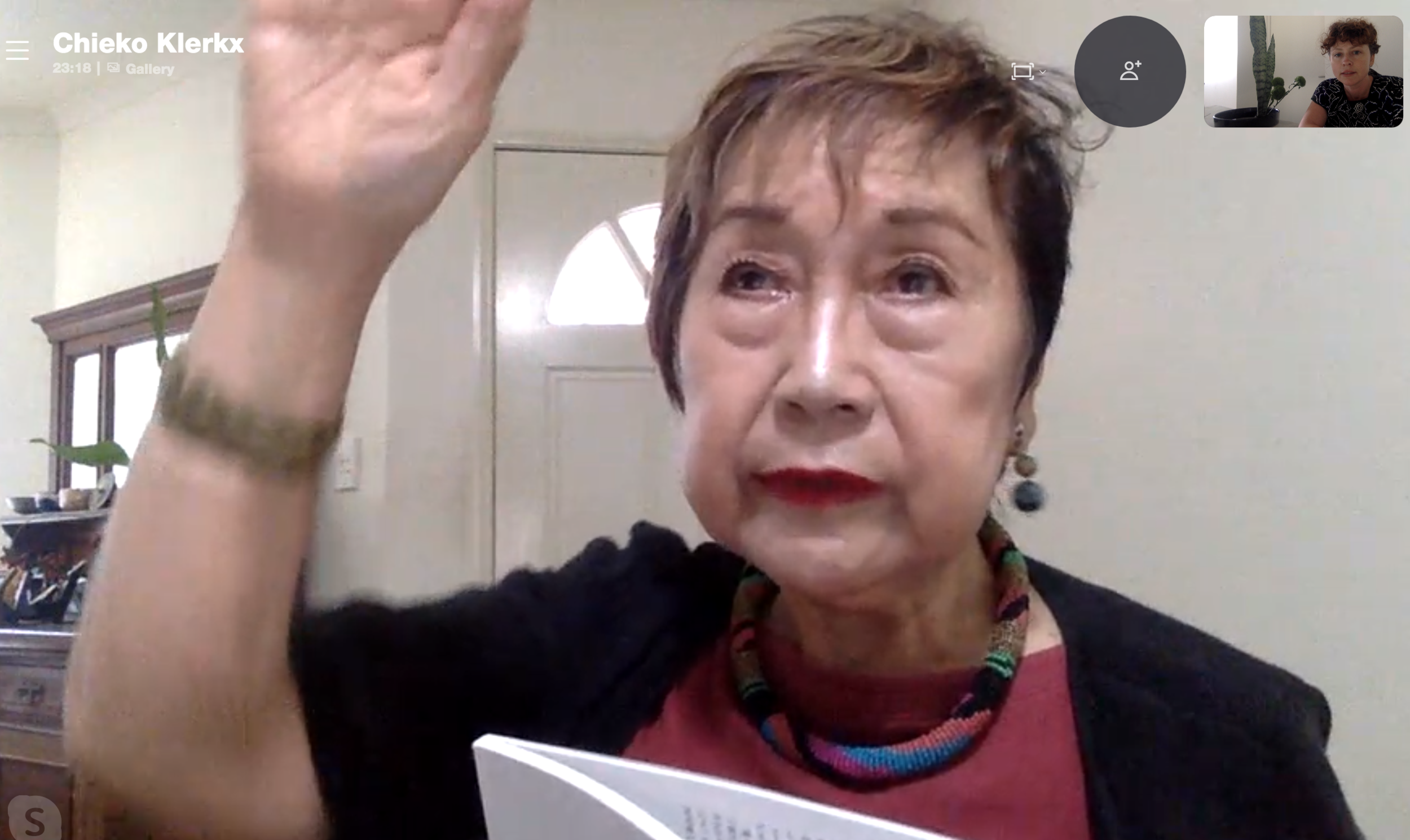


MNEMONIC VEGETABLES
Charlotte Haywood
with invited artists Edward Horne, Kylie Caldwell, Sue Simpson, Shellie Morris, Nini Nahri Galis, Tilly Hewett, Helle Jorgensen, Chieko Klerkx, Emily Lubitz, Selena Murray, Kate Ratner, Jennifer Williams
MNEMONIC VEGETABLES helps us “remember” our connection to the plant world, Mother Earth and each other. Through recent residencies at the Tropical Indigenous Ethnobotany Centre (JCU) Cairns, GoctaLab- Amazonas, Peru, various locations in Mexico and the participation of invited guests; multi-layered stories of plant knowledge, practices, materials and collaborations are honoured through shared process, relationships and sometimes form.
An exhibition in two parts, MNEMONIC VEGETABLES combines the work of Horne’s large-scale outdoor memory circle- The Balancing Act installation in The Quadrangle, with wall works, installation, multi-channel video, community workshops, performance and exchanges by Haywood and invited artists.
The works look at multi-modal mnemonics-or-memory devices, through our relationships to story, mythologies, melodies, dance, landscapes, the plant kingdom, ecologies and ourselves. In this way, the artists create a shared space for reverence and remembrance of our connection to the plant world, the living planet and each other.
The artists would like to thank: Gerry Turpin, Sarah Bolt, Wade Davis, Lynne Kelly, Robin Wall Kimmerer, Hamish McCormick, Sinem Saban, Lauren Tynan and Tyson Yunkaporta.
They acknowledge that works and materials are exhibited and made on the Lands of Widjabul Wya-bal, the greater Bundjalung Nation, Kunwinjku and Githabul peoples; the continuous Traditional Custodians maintaining Land, Culture and plant Knowledge; and that sovereignty was never ceded. Materials have been sought to honour seeding + sustaining positive earth relationships. They have either been harvested and processed locally (Wilsons Creek, North Tumbulgum, Brunswick Heads, Lennox Head, Main Arm, Woodburn) or received through fair trade with responsible harvesting and processing from Gunbalanya community, Arnhem Land, Araliya Community Company, Sri Lanka, and Yucatán, Mexico.
The felled trees for The Balancing Act were part of fire mitigation and will be continually honoured through further artworks and activations.
This project has been assisted by the Australian Government through the Australia Council, its arts funding and advisory body.

Charlotte Haywood with Sue Simpson, Shellie Morris, Emily Lubitz, Jennifer Williams, Tilly Hewett
5:09 mins HD multi-channel video with sound installation
Musical Directors: Sue Simpson + Charlotte Haywood
Sound recording: Charlotte Haywood
Music Mixing: Nicolai Kraus, Charlotte Haywood + Sue Simpson
Camera: Sinem Saban, Hamish McCormick
Video Installation: Rohan Langford + Edward Horne

Charlotte Haywood with Sue Simpson, Shellie Morris, Emily Lubitz, Jennifer Williams, Tilly Hewett
5:09 mins HD multi-channel video with sound installation Musical director: Sue Simpson
Camera: Sinem Saban, Hamish McCormick
Sound recording: Charlotte Haywood
Music Mixing: Nicolai Kraus
Video Installation: Rohan Langford + Edward Horne
An experimental four way video with a female vocalist poised independently singing in various Australian Landscapes; places of personal, cultural, historical or environmental significance.
The 4 ways represent the cardinal points of navigation (North, South, East, West) and further- “wayfinding”- or how to find your way when your environmental-spiritual-cultural-personal- compass is broken.
The women are poised, sentinel like, as cardinal markers in the “landscape”- extending beyond the physical landscape to the spiritual, cultural and psychological.
They are beacons, siren-like, calling to the “lost” (us, themselves, each other) through turbulent times. They carry hope, grief, cycles of life, heartbeat, time, no time and rhythms of nature. Their voices act as a device to tap into emotive states, whilst employing harmonics that point to mnemonic knowledge; embodied- or- remembered knowledge. The voices cycle through solos and harmonies; as heartbeats, time keepers, cycle holders, way finders...
The work is looped, remaining eternal.
The four women include vocalists: Shellie Morris (Wardaman/Yanyuwa), Jennifer Williams (Githabul), Emily Lubitz (Jewish), Tilly Hewett (Australian).
MNEMONIC VEGETABLES Charlotte Haywood & Edward Horne And Invited artists Kylie Caldwell, Tilly Hewett, Helle Jorgensen, Chieko Klerkx, Emily Lubitz, Shellie Morris, Selena Murray, Nini Nahri Galis, Kate Ratner, Sue Simpson, Jennifer Williams
MNEMONIC VEGETABLES helps us “remember” our connection to the plant world, Mother Earth and each other. Through recent residencies at the Tropical Indigenous Ethnobotany Centre (JCU) Cairns, GoctaLab- Amazonas, Peru, various locations in Mexico and the participation of invited guests; multi-layered stories of plant knowledge, practices, materials and collaborations are honoured through shared process, relationships and sometimes form.
An exhibition in two parts, MNEMONIC VEGETABLES combines the work of Horne’s large-scale outdoor memory circle- The Balancing Act installation in The Quadrangle, with wall works, installation, multi-channel video, community workshops, performance and exchanges by Haywood and invited artists. The works look at multi-modal mnemonics-or-memory devices, through our relationships to story, mythologies, melodies, dance, landscapes, the plant kingdom, ecologies and ourselves. In this way, the artists create a shared space for reverence and remembrance of our connection to the plant world, the living planet and each other. The artists would like to thank: Gerry Turpin, Sarah Bolt, Wade Davis, Lynne Kelly, Robin Wall Kimmerer, Nicolai Kraus, Hamish McCormick, Sinem Saban, Lauren Tynan and Tyson Yunkaporta.
They acknowledge that works and materials are exhibited and made on the Lands of Widjabul Wya-bal, the greater Bundjalung Nation, Kunwinjku and Githabul peoples; the continuous Traditional Custodians maintaining Land, Culture and plant Knowledge; and that sovereignty was never ceded. Materials have been sought to honour seeding + sustaining positive earth relationships. They have either been harvested and processed locally (Wilsons Creek, North Tumbulgum, Brunswick Heads, Lennox Head, Main Arm, Woodburn) or received through fair trade with responsible harvesting and processing from Gunbalanya community, Arnhem Land, Araliya Community Company, Sri Lanka, and Yucatán, Mexico. The felled trees for The Balancing Act were part of fire mitigation and will be continually honoured through further artworks and activations.
This project has been assisted by the Australian Government through the Australia Council, its arts funding and advisory body.

Charlotte Haywood with invited artists Kylie Caldwell, Tilly Hewett, Helle Jorgensen, Chieko Klerkx, Emily Lubitz, Shellie Morris, Selena Murray, Nini Nahri Galis, Kate Ratner, Sue Simpson, Jennifer Williams, Edward Horne
Mnemonic Vegetables is a community of seeded relationships and processes that exist within and beyond the gallery. The exhibition houses some of the outcomes or forms, however these are not greater than the sum of the parts. The inherent value is in the space and time created to cultivate and share knowledge, processes, materials and relationships.
The works are often experimental, where there is no set outcome, however the space and intention invoked is to create relationships that honour the plant world, the living planet and ourselves. These are often vulnerable spaces and rely on thresholds of trust, curiosity, generosity, exploration, intuition, adaptability and embodied knowledge.
In looking to create a tapestry of voices, the body of works offers multi modal and multi-lensed view points. Beyond systems of ownership and hierarchies to shared and reciprocal relationships of care and respect.
Extending this idea further is the examination of language and the use of nouns to shape our relationships to sentient beings (Kimmerer). This is displayed in the titles of wall works that elevate plant beings and our relationship with them for their inherent intelligence and non-biased generosity.

Charlotte Haywood with invited artists Kylie Caldwell, Tilly Hewett, Helle Jorgensen, Chieko Klerkx, Emily Lubitz, Shellie Morris, Selena Murray, Nini Nahri Galis, Kate Ratner, Sue Simpson, Jennifer Williams, Edward Horne
Mnemonic Vegetables is a community of seeded relationships and processes that exist within and beyond the gallery. The exhibition houses some of the outcomes or forms, however these are not greater than the sum of the parts. The inherent value is in the space and time created to cultivate and share knowledge, processes, materials and relationships.
The works are often experimental, where there is no set outcome, however the space and intention invoked is to create relationships that honour the plant world, the living planet and ourselves. These are often vulnerable spaces and rely on thresholds of trust, curiosity, generosity, exploration, intuition, adaptability and embodied knowledge.
In looking to create a tapestry of voices, the body of works offers multi modal and multi-lensed view points. Beyond systems of ownership and hierarchies to shared and reciprocal relationships of care and respect.
Extending this idea further is the examination of language and the use of nouns to shape our relationships to sentient beings (Kimmerer). This is displayed in the titles of wall works that elevate plant beings and our relationship with them for their inherent intelligence and non-biased generosity.

ephemeral installation collected and processed on the lands of Bundjalung, Kunwinjku, Wonnarua and Yuacatec Maya peoples: pandanus from Gunbalanya community, turmeric from Wilsons Creek, olive leaf from Koonyum Range, buckie rush collected with Kylie Caldwell in Lennox Head, banana fibre processed with Helle Jorgensen in North Tumbulgum, agave from Yucatan, wattle from Main Arm, gourd from Maitland, collected black butt timber
What does the future hold, our horizon? Enmeshed knowledge systems, or those like islands unto themselves…

ephemeral installation collected and processed on the lands of Bundjalung, Kunwinjku, Wonnarua and Yuacatec Maya peoples: pandanus from Gunbalanya Community, turmeric from Wilsons Creek, olive leaf from Koonyum Range, buckie rush collected with Kylie Caldwell in Lennox Head, banana fibre processed with Helle Jorgensen in North Tumbulgum, agave from Yucatan, wattle from Main Arm, gourd from Maitland, collected black butt timber
What does the future hold, our horizon?
Enmeshed knowledge systems, or those like islands unto themselves…

79cm x 119 cm
Blackbutt, sasawashi bamboo, agave, cotton warp
Webs of life; of the awake and the dreaming. Suspended. The glistening thread of an idea, the conduit of thought; enmeshed networks, stories, embodied knowledge, entangled consciousness.
...
Tapestries of the senses, amongst constellations of beings. ...
A state of being. A moment in time. Constructed interpretations of reality.
...
Exchanges and feedback loops, births and deaths and everything in between feeding on intermittent tensions. Rhythmically.

79cm x 119 cm
Blackbutt, sasawashi bamboo, agave, cotton warp
Webs of life; of the awake and the dreaming. Suspended. The glistening thread of an idea, the conduit of thought; enmeshed networks, stories, embodied knowledge, entangled consciousness.
...
Tapestries of the senses, amongst constellations of beings. ...
A state of being. A moment in time. Constructed interpretations of reality.
...
Exchanges and feedback loops, births and deaths and everything in between feeding on intermittent tensions. Rhythmically.

30cm x 20cm
buckie rush, lomandra
Kylie Caldwell is a multidisciplinary artist and Bundjalung woman who has been regenerating Bundjalung weaving, researching museum collections in Australia and overseas. She is an ardent weaver and fibre artist.
For Mnemonic Vegetables, she delivered public workshops teaching introductory techniques in traditional and contemporary basket weaving, using locally sourced and hand picked natural materials.

56cm x 106cm
Blackbutt, coconut coir, banana silk, raffia, buckie rush collected with Kylie Caldwell, agave, banana fibre processed with Helle Jorgensen, jute, corn husk, gourd, cotton warp, sprouted coconut, fire mitigation felled blood wood log

56cm x 106cm
Blackbutt, coconut coir, banana silk, raffia, buckie rush collected with Kylie Caldwell, agave, banana fibre processed with Helle Jorgensen, jute, corn husk, gourd, cotton warp

56cm x 106cm
Blackbutt, coconut coir, banana silk, raffia, buckie rush collected with Kylie Caldwell, agave, banana fibre processed with Helle Jorgensen, jute, corn husk, gourd, cotton warp, sprouted coconut, fire mitigation felled blood wood log

70cm x 70cm
Blackbutt, banana fibre processed with Helle Jorgensen, collected buckie rush with Kylie Caldwell, banana silk, raffia, sasawashi bamboo, agave, jute, raffia, cotton warp
The Knowledge Holders is a work invoked through time spent with Mbabaram Elder and Australia’s Lead Ethnobotanist Gerry Turpin on Country and at the Tropical Indigenous Ethnobotany Centre (TIEC), Cairns. It also looks at seeds as holding the power of inherent knowledge, sovereignty, and for reclaiming traditional methods of agriculture in order to secure a healthy and nourishing future for all.
This work is inspired by the seedpods: of the Dundil - Malikini - Balkpalk - peanut tree -sterculia quadrifa whose Cultural holders of this plant are: the Tiwi, Wik, Larrakia, Yolngu, Uw Oykangand, Ow Olkola, Pakanh... And River red gum (Eucalyptus camaldulensis) who has strong cultural, political and social connection across Austalia ….And rainforest gourd (Trichosanthes sp.) which I spent time with Gerry searching for Language and Cultural uses of gourds in First Nations Australia….
“Ethnobotany is the study of cultural plant use and perception of plants. Indigenous Australians have used plants for food, medicine, tools, utensils, weapons, etc. for tens of thousands of years. However, since the arrival of Europeans, a lot of traditional plant use knowledge has been lost.
The TIEC aims to empower Indigenous people to renew and strengthen their Cultural Knowledge and practices about plants. Many Traditional Owners believe that keeping their Knowledge alive and passing it on to the next generation is very important. The TIEC will support Traditional Owner information sharing, practice and collaboration, and also support keeping plant collections and data for Traditional Owners through shared protocols and agreements.”- TIEC

70cm x 70cm
Blackbutt, banana fibre processed with Helle Jorgensen, collected buckie rush with Kylie Caldwell, banana silk, raffia, sasawashi bamboo, agave, jute, raffia, cotton warp
The Knowledge Holders is a work invoked through time spent with Mbabaram Elder and Australia’s Lead Ethnobotanist Gerry Turpin on Mbabaram Country, and at the Tropical Indigenous Ethnobotany Centre (TIEC), Cairns. It also looks at seeds as holding the power of inherent knowledge, sovereignty, and for reclaiming traditional methods of agriculture in order to secure a healthy and nourishing future for all.
This work is inspired by the seedpods: of the Dundil/ Malikini/Balkpalk /peanuttree /Sterculia quadrifa whose Cultural holders of this plant are: the Tiwi, Wik, Larrakia, Yolngu, Uw Oykangand, Ow Olkola, Pakanh... And River red gum (Eucalyptus camaldulensis) who has strong cultural, political and social connection across Austalia ….And rainforest gourd (Trichosanthes sp.) which I spent time with Gerry searching for Language and Cultural uses of gourds in First Nations Australia….
“Ethnobotany is the study of cultural plant use and perception of plants. Indigenous Australians have used plants for food, medicine, tools, utensils, weapons, etc. for tens of thousands of years. However, since the arrival of Europeans, a lot of traditional plant use knowledge has been lost. The TIEC aims to empower Indigenous people to renew and strengthen their Cultural Knowledge and practices about plants. Many Traditional Owners believe that keeping their Knowledge alive and passing it on to the next generation is very important. The TIEC will support Traditional Owner information sharing, practice and collaboration, and also support keeping plant collections and data for Traditional Owners through shared protocols and agreements.”- TIEC

70cm x 70cm
Blackbutt, banana fibre processed with Helle Jorgensen, collected buckie rush with Kylie Caldwell, banana silk, raffia, sasawashi bamboo, agave, jute, raffia, cotton warp
The Knowledge Holders is a work invoked through time spent with Mbabaram Elder and Australia’s Lead Ethnobotanist Gerry Turpin on Mbabaram Country, and at the Tropical Indigenous Ethnobotany Centre (TIEC), Cairns. It also looks at seeds as holding the power of inherent knowledge, sovereignty, and for reclaiming traditional methods of agriculture in order to secure a healthy and nourishing future for all.
This work is inspired by the seedpods: of the Dundil/ Malikini/Balkpalk /peanuttree /Sterculia quadrifa whose Cultural holders of this plant are: the Tiwi, Wik, Larrakia, Yolngu, Uw Oykangand, Ow Olkola, Pakanh... And River red gum (Eucalyptus camaldulensis) who has strong cultural, political and social connection across Austalia ….And rainforest gourd (Trichosanthes sp.) which I spent time with Gerry searching for Language and Cultural uses of gourds in First Nations Australia….
“Ethnobotany is the study of cultural plant use and perception of plants. Indigenous Australians have used plants for food, medicine, tools, utensils, weapons, etc. for tens of thousands of years. However, since the arrival of Europeans, a lot of traditional plant use knowledge has been lost. The TIEC aims to empower Indigenous people to renew and strengthen their Cultural Knowledge and practices about plants. Many Traditional Owners believe that keeping their Knowledge alive and passing it on to the next generation is very important. The TIEC will support Traditional Owner information sharing, practice and collaboration, and also support keeping plant collections and data for Traditional Owners through shared protocols and agreements.”- TIEC

70cm x 70cm
Blackbutt, banana fibre processed with Helle Jorgensen, collected buckie rush with Kylie Caldwell, banana silk, raffia, sasawashi bamboo, agave, jute, raffia, cotton warp

37cm x 80cm
Hoop Pine, banana silk, raffia, sasawashi bamboo, collected buckie rush with Kylie Caldwell, agave, paper bark, cotton warp, banana flower, bush fire mitigation felled bloodwood log
“Plants know how to make food and medicine from sunlight and water and they give it away”- Robin Wall Kimmerer

37cm x 80cm
Hoop Pine, banana silk, raffia, sasawashi bamboo, collected buckie rush with Kylie Caldwell, agave, paper bark, cotton warp
“Plants know how to make food and medicine from sunlight and water and they give it away”- Robin Wall Kimmerer

37cm x 80cm
Hoop Pine, banana silk, raffia, sasawashi bamboo, collected buckie rush with Kylie Caldwell, agave, paper bark, cotton warp

56cm x 48cm
Hoop pine, banana fibre processed with Helle Jorgensen, banana silk, sasawashi bamboo, buckie rush collected with Kylie Caldwell, agave, jute, cotton warp
‘It is no sign of good health to be well adjusted to a sick society’- Krishnamurti
With the worldview ethic of exploitation how do we cultivate honourable relations to the living earth, each other? Where children can recognise more plant species over logos?
Strong as a tree, as fragile as a reed….the genesis of metaphor, story and knowledge stems from the plant world and living planet.
Plants are intelligent and they can remember. They have sensory responses to their environment, each other, friend and predator. These responses help them adapt, communicate and survive, together. Their relationships flourish through biodiversity, interspecies mutualism; creating networks of reciprocity, communities of shared resources. Entangled, Interwoven, interconnected, wholistic; the web of life.
The limits of language are not the same as the limits of knowing.
“Grammar is how we chart relationships in language… The stories we choose to shape our behaviours have adaptive consequences…
Because we speak and live with this language every day, our minds have also been colonised by this notion that the nonhuman living world and the world of inanimate objects have equal status. Bulldozers, buttons, berries, and butterflies are all referred to as it, as things, whether they are inanimate industrial products or living beings…[W]e need words that heal that relationship, that invite us into an inclusive worldview of personhood for all beings”. - Robin Wall Kimmerer
Our dominant system provides science; as islands of knowledge. Quantitative matter. Taxonomically measured and hierarchically placed.
Pluralities. Life is an embodied network. Food is power; through transference of energy from one life to another.

56cm x 48cm
Hoop pine, banana fibre processed with Helle Jorgensen, banana silk, sasawashi bamboo, buckie rush collected with Kylie Caldwell, agave, jute, cotton warp
“Grammar is how we chart relationships in language…
The stories we choose to shape our behaviours have adaptive consequences”- Robin Wall Kimmerer

56cm x 48cm
Hoop pine, banana fibre processed with Helle Jorgensen, banana silk, sasawashi bamboo, buckie rush collected with Kylie Caldwell, agave, jute, cotton warp
‘It is no sign of good health to be well adjusted to a sick society’- Krishnamurti
With the worldview ethic of exploitation how do we cultivate honourable relations to the living earth, each other? Where children can recognise more plant species over logos?
Strong as a tree, as fragile as a reed….the genesis of metaphor, story and knowledge stems from the plant world and living planet.
Plants are intelligent and they can remember. They have sensory responses to their environment, each other, friend and predator. These responses help them adapt, communicate and survive, together. Their relationships flourish through biodiversity, interspecies mutualism; creating networks of reciprocity, communities of shared resources. Entangled, Interwoven, interconnected, wholistic; the web of life.
The limits of language are not the same as the limits of knowing. “Grammar is how we chart relationships in language… The stories we choose to shape our behaviours have adaptive consequences… Because we speak and live with this language every day, our minds have also been colonised by this notion that the nonhuman living world and the world of inanimate objects have equal status. Bulldozers, buttons, berries, and butterflies are all referred to as it, as things, whether they are inanimate industrial products or living beings…[W]e need words that heal that relationship, that invite us into an inclusive worldview of personhood for all beings”. - Robin Wall Kimmerer
Our dominant system provides science; as islands of knowledge. Quantitative matter. Taxonomically measured and hierarchically placed.
Pluralities. Life is an embodied network. Food is power; through transference of energy from one life to another.

30cm x 18cm x 15cm
buckie rush
“The Natives is a piece recognising provenance which is widely valued and respected culturally. To know one’s origins offers deeper understanding other than self. It’s not only where you are but who is with you and what places, spaces, soils and aqua system you share. The Natives know places through their connectivity.”- Kylie Caldwell
Kylie Caldwell is a multidisciplinary artist and Bundjalung woman who has been regenerating Bundjalung weaving, researching museum collections in Australia and overseas. She is an ardent weaver and fibre artist.
For Mnemonic Vegetables, she delivered public workshops teaching sharing introductory techniques in traditional and contemporary basket weaving, using locally sourced and hand picked natural materials.

burnt camphor laurel timber
Inspired by cotyledon or seed leafs of embryonic plants and the shape shifting Boquila trifoliolata plant of the rainforests of Chile and Argentina; a vine that can “see” and change the shape of its leaves to emulate its host through mimicry. Its versatile leaves can change their size, shape, colour, orientation, even the vein patterns to match the surrounding foliage.
Looking further or closer; Australia has its own mimic or shape shifting plant- recently “discovered” or identified by Dr Russell Barrett- the Lechenaultia mimica in the remote Harding Ranges of the Kimberley. Wonder what the Wunambal Gaambera people have known about this plant?

THE SHAPESHIFTERS, 2020
Burnt camphor laurel
Inspired by cotyledon or seed leafs of embryonic plants and the shape shifting Boquila trifoliolata plant of the rainforests of Chile and Argentina; a vine that can “see” and change the shape of its leaves to emulate its host through mimicry. Its versatile leaves can change their size, shape, colour, orientation, even the vein patterns to match the surrounding foliage.
Looking further or closer; Australia has its own mimic or shape shifting plant- recently “discovered” or identified by Dr Russell Barrett- the Lechenaultia mimica in the remote Harding Ranges of the Kimberley. Wonder what the Wunambal Gaambera people have known about this plant?

burnt camphor laurel timber
Inspired by cotyledon or seed leafs of embryonic plants and the shape shifting Boquila trifoliolata plant of the rainforests of Chile and Argentina; a vine that can “see” and change the shape of its leaves to emulate its host through mimicry. Its versatile leaves can change their size, shape, colour, orientation, even the vein patterns to match the surrounding foliage.
Looking further or closer; Australia has its own mimic or shape shifting plant- recently “discovered” or identified by Dr Russell Barrett- the Lechenaultia mimica in the remote Harding Ranges of the Kimberley. Wonder what the Wunambal Gaambera people have known about this plant?

burnt camphor laurel timber
Inspired by cotyledon or seed leafs of embryonic plants and the shape shifting Boquila trifoliolata plant of the rainforests of Chile and Argentina; a vine that can “see” and change the shape of its leaves to emulate its host through mimicry. Its versatile leaves can change their size, shape, colour, orientation, even the vein patterns to match the surrounding foliage.
Looking further or closer; Australia has its own mimic or shape shifting plant- recently “discovered” or identified by Dr Russell Barrett- the Lechenaultia mimica in the remote Harding Ranges of the Kimberley. Wonder what the Wunambal Gaambera people have known about this plant?

burnt timber (species unknown), fire mitigation felled bloodwood, pumpkin

45cm x 75cm
camphor laurel timber, banana silk, sasawashi bamboo, agave, jute, cotton warp, fire mitigation felled bloodwood, lichen, driftwood, Grub by Kate Ratner
The gift of time. Time is in inherent in plants.
Plants have an internal timekeeper or circadian clock. This biological timer gives plants an innate ability to measure time, even when there is no light - they don’t simply respond to sunrise, they know it is coming and adjust their biology accordingly. This ability to keep time is vital in biological processes such as flowering, fragrance emission and leaf movement.
Indigenous Calendar plants are signs or pointers in the landscape that describe seasonal changes, interrelatedness, synchronicity, fertility cycles and an understanding and respect for plants and the living landscape.
How do we read the landscape, the plants and sun,? How do we know what season it is or when the fledglings come? ….the shedding of skins, transformations, when the nectars are full and provide for all beings, or the bloomings of flowers that indicate heat is on the way….?
We have lost our synchronisation with nature and are left with the Gregorian calendar, based on the birth, life and death of one man…an artificial time whereby we have convinced ourselves that time is money.
Gregarious flowering of certain species of woody Bamboo display it’s own synchronicity and interconnectedness…. These slow flowering species flower every 30-120 years- all at the same time, all over the world, irrespective of geographic location and climate, as long as they were derived from the same mother plant. It is unknown how this happens but speculated that there must be a genetic alarm in each bamboo cell.

45cm x 75cm
camphor laurel timber, banana silk, sasawashi bamboo, agave, jute, cotton warp
The gift of time. Time is in inherent in plants.
Plants have an internal timekeeper or circadian clock. This biological timer gives plants an innate ability to measure time, even when there is no light - they don’t simply respond to sunrise, they know it is coming and adjust their biology accordingly. This ability to keep time is vital in biological processes such as flowering, fragrance emission and leaf movement.
Indigenous Calendar plants are signs or pointers in the landscape that describe seasonal changes, interrelatedness, synchronicity, fertility cycles and an understanding and respect for plants and the living landscape.
How do we read the landscape, the plants and sun? How do we know what season it is or when the fledglings come? ….the shedding of skins, transformations, when the nectars are full and provide for all beings, or the bloomings of flowers that indicate heat is on the way….?
We have lost our synchronisation with nature and are left with the Gregorian calendar, based on the birth, life and death of one man…an artificial time whereby we have convinced ourselves that time is money.
Gregarious flowering of certain species of woody Bamboo display it’s own synchronicity and interconnectedness…. These slow flowering species flower every 30-120 years- all at the same time, all over the world, irrespective of geographic location and climate, as long as they were derived from the same mother plant. It is unknown how this happens but speculated that there must be a genetic alarm in each bamboo cell.

45cm x 75cm
camphor laurel timber, banana silk, sasawashi bamboo, agave, jute, cotton warp
The gift of time. Time is in inherent in plants.
Plants have an internal timekeeper or circadian clock. This biological timer gives plants an innate ability to measure time, even when there is no light - they don’t simply respond to sunrise, they know it is coming and adjust their biology accordingly. This ability to keep time is vital in biological processes such as flowering, fragrance emission and leaf movement.
Indigenous Calendar plants are signs or pointers in the landscape that describe seasonal changes, interrelatedness, synchronicity, fertility cycles and an understanding and respect for plants and the living landscape.
How do we read the landscape, the plants and sun,? How do we know what season it is or when the fledglings come? ….the shedding of skins, transformations, when the nectars are full and provide for all beings, or the bloomings of flowers that indicate heat is on the way….?
We have lost our synchronisation with nature and are left with the Gregorian calendar, based on the birth, life and death of one man…an artificial time whereby we have convinced ourselves that time is money.
Gregarious flowering of certain species of woody Bamboo display it’s own synchronicity and interconnectedness…. These slow flowering species flower every 30-120 years- all at the same time, all over the world, irrespective of geographic location and climate, as long as they were derived from the same mother plant. It is unknown how this happens but speculated that there must be a genetic alarm in each bamboo cell.

45cm x 75cm camphor laurel timber, banana silk, sasawashi bamboo, agave, jute, cotton warp
The gift of time. Time is in inherent in plants.
Plants have an internal timekeeper or circadian clock. This biological timer gives plants an innate ability to measure time, even when there is no light - they don’t simply respond to sunrise, they know it is coming and adjust their biology accordingly. This ability to keep time is vital in biological processes such as flowering, fragrance emission and leaf movement.
Indigenous Calendar plants are signs or pointers in the landscape that describe seasonal changes, interrelatedness, synchronicity, fertility cycles and an understanding and respect for plants and the living landscape.
How do we read the landscape, the plants and sun,? How do we know what season it is or when the fledglings come? ….the shedding of skins, transformations, when the nectars are full and provide for all beings, or the bloomings of flowers that indicate heat is on the way….?
We have lost our synchronisation with nature and are left with the Gregorian calendar, based on the birth, life and death of one man…an artificial time whereby we have convinced ourselves that time is money.
Gregarious flowering of certain species of woody Bamboo display it’s own synchronicity and interconnectedness…. These slow flowering species flower every 30-120 years- all at the same time, all over the world, irrespective of geographic location and climate, as long as they were derived from the same mother plant. It is unknown how this happens but speculated that there must be a genetic alarm in each bamboo cell.

45cm x 75cm camphor laurel timber, banana silk, sasawashi bamboo, agave, jute, cotton warp
The gift of time. Time is in inherent in plants.
Plants have an internal timekeeper or circadian clock. This biological timer gives plants an innate ability to measure time, even when there is no light - they don’t simply respond to sunrise, they know it is coming and adjust their biology accordingly. This ability to keep time is vital in biological processes such as flowering, fragrance emission and leaf movement.
Indigenous Calendar plants are signs or pointers in the landscape that describe seasonal changes, interrelatedness, synchronicity, fertility cycles and an understanding and respect for plants and the living landscape.
How do we read the landscape, the plants and sun,? How do we know what season it is or when the fledglings come? ….the shedding of skins, transformations, when the nectars are full and provide for all beings, or the bloomings of flowers that indicate heat is on the way….?
We have lost our synchronisation with nature and are left with the Gregorian calendar, based on the birth, life and death of one man…an artificial time whereby we have convinced ourselves that time is money.
Gregarious flowering of certain species of woody Bamboo display it’s own synchronicity and interconnectedness…. These slow flowering species flower every 30-120 years- all at the same time, all over the world, irrespective of geographic location and climate, as long as they were derived from the same mother plant. It is unknown how this happens but speculated that there must be a genetic alarm in each bamboo cell.

Banana fibre, ceramic
Banana is an abundant agricultural crop in the Northern Rivers region. Although grown for its fruit, it's also possible to use the trunk for basketry and cordage.
Helle Jorgensen is a Northern NSW artist, with a background in Biology and Horticulture. Her artistic process is primarily based on investigating materials and techniques. In 2017 she had a residency in a small village in Northern Okinawa, Japan, where she expanded her knowledge in banana fibre processing and its use.

banana fibre, ceramic
Banana is an abundant agricultural crop in the Northern Rivers region. Although grown for its fruit, it's also possible to use the trunk for basketry and cordage.
Helle Jorgensen is a Northern NSW artist, with a background in Biology and Horticulture. Her artistic process is primarily based on investigating materials and techniques. In 2017 she had a residency in a small village in Northern Okinawa, Japan, where she expanded her knowledge in banana fibre processing and its use

banana fibre, ceramic
Banana is an abundant agricultural crop in the Northern Rivers region. Although grown for its fruit, it's also possible to use the trunk for basketry and cordage.
Helle Jorgensen is a Northern NSW artist, with a background in Biology and Horticulture. Her artistic process is primarily based on investigating materials and techniques. In 2017 she had a residency in a small village in Northern Okinawa, Japan, where she expanded her knowledge in banana fibre processing and its use

Safety Goggles For Lofty Thoughts Processor
banana fibre, ceramic, lichen
Knotless Netted Bag
banana fibre
Processed banana fibre
Banana is an abundant agricultural crop in the Northern Rivers region. Although grown for its fruit, it's also possible to use the trunk for basketry and cordage.
Helle Jorgensen is a Northern NSW artist, with a background in Biology and Horticulture. Her artistic process is primarily based on investigating materials and techniques. In 2017 she had a residency in a small village in Northern Okinawa, Japan, where she expanded her knowledge in banana fibre processing and its use

banana fibre, ceramic, lichen
Banana is an abundant agricultural crop in the Northern Rivers region. Although grown for its fruit, it's also possible to use the trunk for basketry and cordage.
Helle Jorgensen is a Northern NSW artist, with a background in Biology and Horticulture. Her artistic process is primarily based on investigating materials and techniques. In 2017 she had a residency in a small village in Northern Okinawa, Japan, where she expanded her knowledge in banana fibre processing and its use

Chieko Klerkx + Charlotte Haywood
A series of collaborative ikebana sessions honouring the master-student relationship, created across borders via skype.

Chieko Klerkx + Charlotte Haywood
A series of collaborative ikebana sessions honouring the master-student relationship, created across borders via skype.

Chieko Klerkx + Charlotte Haywood
A series of collaborative ikebana sessions honouring the master-student relationship, created across borders via skype.

Chieko Klerkx + Charlotte Haywood
A series of collaborative ikebana sessions honouring the master-student relationship, created across borders via skype.

Black butt, blood wood, scribbly gum, steel
We see-we saw- our relationship with the living planet at tipping point. The would be see-saws are fixed, there is no give and take. They are constructed between the dominant “laws” of humankind and nature.
These trees have been cut down for fire mitigation. They carry both trauma and hope of our current imbalance with nature and ourselves. The trees are assembled as a wayfinding device, as cardinal points, symbolic of finding our way back to attuned relationships of reciprocity.
Here, the reciprocal relationship is suspended in time, The Balancing Act gives space to remember through play, performance, community engagement and exchange. Whilst the shadow of the felled trees allows sunlight to grow food.
The felled trees for The Balancing Act will be continually honoured through further artworks and activations.

NINI NAHRI GALIS perform a new Bundjalung plant, seed, lomandra and weaving dance in THE BALANCING ACT in response to MNEMONIC VEGETABLES exhibition using vocals from the video work THE WAYFINDERS with Shellie Morris, Emily Lubitz, Jennifer Williams, Tilly Hewett.

Black butt, blood wood, scribbly gum, steel
We see-we saw- our relationship with the living planet at tipping point. The would be see-saws are fixed, there is no give and take. They are constructed between the dominant “laws” of humankind and nature.
These trees have been cut down for fire mitigation. They carry both trauma and hope of our current imbalance with nature and ourselves. The trees are assembled as a wayfinding device, as cardinal points, symbolic of finding our way back to attuned relationships of reciprocity.
Here, the reciprocal relationship is suspended in time, The Balancing Act gives space to remember through play, performance, community engagement and exchange. Whilst the shadow of the felled trees allows sunlight to grow food.
(The felled trees for The Balancing Act will be continually honoured through further artworks and activations. )

Black butt, blood wood, scribbly gum, steel
We see-we saw- our relationship with the living planet at tipping point. The would be see-saws are fixed, there is no give and take. They are constructed between the dominant “laws” of humankind and nature.
These trees have been cut down for fire mitigation. They carry both trauma and hope of our current imbalance with nature and ourselves. The trees are assembled as a wayfinding device, as cardinal points, symbolic of finding our way back to attuned relationships of reciprocity.
Here, the reciprocal relationship is suspended in time, The Balancing Act gives space to remember through play, performance, community engagement and exchange. Whilst the shadow of the felled trees allows sunlight to grow food.
The felled trees for The Balancing Act will be continually honoured through further artworks and activations.

Plant, seed & Knowledge Exchange
with Bundjalung Widjabul Wia-bal Elders Auntie Thelma James, Uncle Mick Roberts, host of ABC North Coast Radio's Good Gardening Phil Dudman & Environmental Scientist Michelle Chapman from SEEDTREE MAPS, as part of Mnemonic Vegetables Exhibition.
Participants brought in seeds, seedlings, cuttings, plants and Knowledge to swap. Focusing on food plants, heirloom varieties, saved seed, local natives & natives.

Kylie Caldwell is a multidisciplinary artist and Bundjalung woman who has been regenerating Bundjalung weaving, researching museum collections in Australia and overseas. She is an ardent weaver and fibre artist who shared Knowledge during MNEMONIC VEGETABLES.

Plants are Magic workshops for local homeschool kids and their carers as a part of MNEMONIC VEGETABLES exhibition by Kirsty Mootz from Parva. Discovering how to use common weeds, local flowers and home grown herbs to make simple skincare. Using what you have on hand to create a little bit of magic

Banana is an abundant agricultural crop in the Northern Rivers region. Although grown for its fruit, it's also possible to use the trunk for basketry and cordage. This workshop showed participants how to harvest and process the banana plant and how to make material suitable for basketry techniques and cordage making.
Helle Jorgensen is a Northern NSW artist, with a background in Biology and Horticulture. Her artistic process is primarily based on investigating materials and techniques. In 2017 she had a residency in a small village in Northern Okinawa, Japan, where she expanded her knowledge in banana fibre processing and its use.